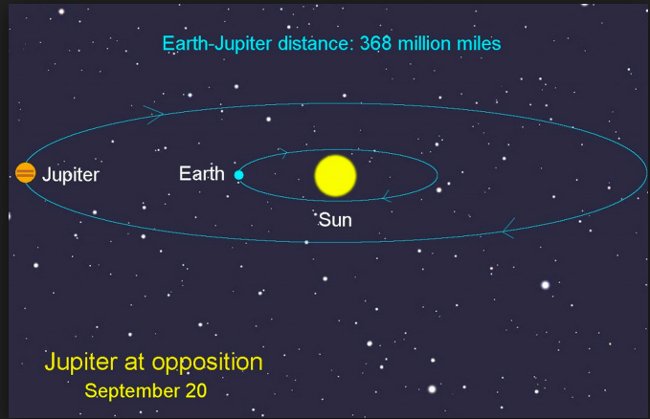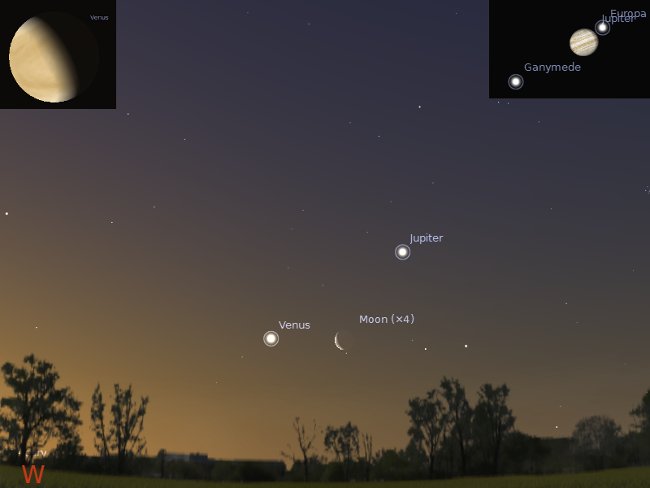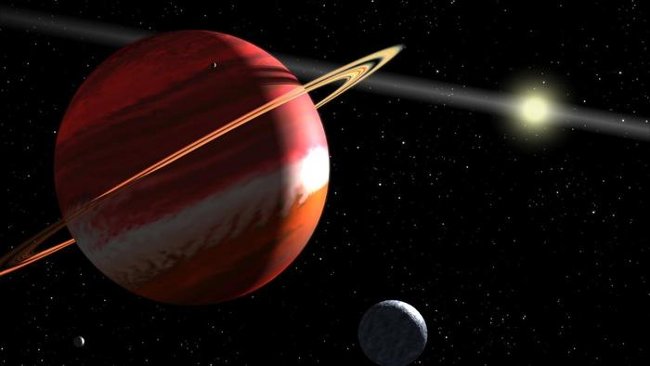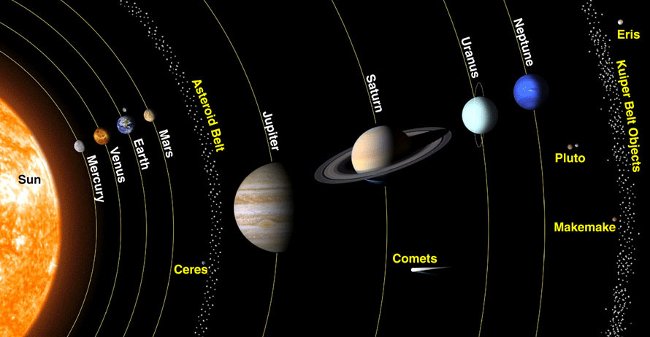The distance from Earth to Jupiter - what is the largest planet of the solar system?
- Space Science: The order of 8 (or 9) planets in the Solar System
- NASA discovered water in planetary Neptune's atmosphere
- What is gamma-ray burst?
Do you know the distance from Earth to Jupiter - what is the largest planet of the solar system? Let's TipsMake.com find out!
As the largest planet in the solar system, Jupiter illuminates the sky despite geographical distance. Venus is the only planet that is brighter than this giant gas planet, although sometimes Mars also poses some challenges to it. Part of this is related to the size and composition of Jupiter, but the planet grows brighter or dimmer depending on the distance from Earth to it.
 Photograph of Jupiter and the Moon on the morning of September 8, 2012. Photo Source: Starry Night software
Photograph of Jupiter and the Moon on the morning of September 8, 2012. Photo Source: Starry Night software
The distance from Earth to Jupiter?
Because both planets run on an elliptical circle orbiting the Sun, the distance from Earth to Jupiter is constantly changing. When the two planets move to the nearest location, the distance to Jupiter is only 365 million miles ( 588 million km ). From its nearest position, Jupiter shines, even to Venus, when it is compared to it. At the farthest location, the giant gas planet is 601 million miles from Earth (968 million km).

Jupiter must take 11.86 years of Earth to complete an orbit around the Sun. When the Earth rotates around the Sun, it will meet Jupiter at 398.9 days, making this giant gas planet seem to go back in the night sky. This reverse motion caused some problems for the central solar system models ( or "Copernic" ), perfect circles that did not explain the loop of Jupiter and planets clearly. Other created. It was not until Johannes Kepler determined that the planets moved in elliptical circles rather than circles, then the problem was clarified.
See also: Unknown things about asteroid belt
Distance from Jupiter to the Sun?
When moving in an elliptical circle, these planets are not always at a constant distance from the Sun. At its nearest location, or near-Japan point, Jupiter lies 460 million miles from the stars (741 million km); also at the farthest position, or a far-sighted point of 508 million miles (817 million kilometers). The average distance from Earth to Jupiter is 484 million miles (778 million km).

When the two planets move around each other, the system has its own center of mass usually located near the heavier. This is the point where both planets are spinning around. So even though planets orbit around the Sun, both the Sun and the actual planets revolve around the center of mass. This means that planets have a center of mass not only with the Sun but also with other planets. However, the giant Sun dominates between the center of mass, the Earth and Mercury.
In the solar system, the center of most solar system ( Sun-Earth, Sun - Venus, . ) lies within our giant star. But because Jupiter is so big, the center of mass in the solar system - Jupiter is actually outside the diameter of the Sun. This is the only planet whose center of mass does not lie on the boundary of the Sun. When Jupiter orbits the Sun, the giant planet strongly tugs its star. When observing similar movements in other stars, scientists allowed the discovery of some of the first extrasolar planets.
See also: Discover the incredible facts about our cosmic planet
How long does it take to reach Jupiter?

The amount of time it takes for the spacecraft to reach the giant gas planet depends on a number of conditions. The movements of spacecraft are often different, because it flies out of planets, the Moon and even the Sun to accelerate while using less fuel.
The Galileo spacecraft was launched in October 1989. It only took more than six years to reach the giant planet and arrive in December 1995. However, the Galileo spacecraft flew along its winding road, moving one. a distance of 2.5 billion miles through Venus, Earth and asteroid Gaspra to reach Jupiter.
On the other hand, Voyager 1 only takes two years to reach the giant planet. Launched on September 5, 1977, Voyager 1 approached the giant planet at the nearest location on March 5, 1979. This Voyager mission was designed to take advantage of the ideal layout of outer planets.

The mission of New Horizons had a clearer route after its launch on January 19, 2006. On February 28, 2007, she made a flight to Jupiter on her way to Pluto and planets. another dwarf. Travel time to Jupiter only takes more than 13 months.
Juno , launched on August 5, 2011, took 5 years to reach the giant planet, July 4, 2016.
The European Space Agency has launched a plan to launch Jupiter ICY Moons Explorer (JUICE) to Jupiter in June 2022. JUICE will rely on the attraction from Venus and Earth to make the journey of 7.6 years on board. This giant gas.
NASA said it will launch the Europa Clipper spacecraft, to Jupiter's Europa Moon expected to arrive in 2020. The missile system launches NASA's Space Launch System - SLS as the next missile model. The space shuttle, probably ready to take off in early 2018. When leaving the launch pad, it can carry 70 tons of cargo to orbit and reduce travel time from 8 years to 3 years.
" This is one of those rare cases when time is really money, " said former astronaut John Grunsfeld , deputy manager at NASA's Science Mission - Science Mission Directorate in July 2015. .
The time to travel to the giant planet of each mission is different, not only depending on propulsion technology, but also depending on the order of the planets.
See also: Stephen Hawking and 32 leading physicists signed a letter of defense of the doctrine of the origin of the universe
Having fun!
You should read it
- NASA announces a stunning series of GIF images that capture the historic moments of the aerospace industry
- NASA will launch new space telescope into space to find 'second earth'
- How big is the solar system?
- Hot Jupiter is being torn apart by its host star
- Space Science: The order of 8 (or 9) planets in the Solar System
- 2 more moons found around Jupiter
- What happens when the Moon is close to Earth, at a distance of 420 km like the International Space Station (ISS) today?
- Earth is light despite receiving 43 tons of dust from other planets every day
- How far is the distance from Earth to Mercury?
- NASA's space telescope finds three new planets with rare features
- 7 future historic space missions of NASA
- The discovery of the 'Second Earth' can exist only 4.2 light-years away from Earth
May be interested

If people fall into a black hole, what horrors will await them?

12 interesting facts about Red Planet - Mars may not be known

Discovering new gravitational waves from two black holes collides 3 billion light-years away

40 interesting facts you didn't know about the Sun.

How fast can a rocket fly to win gravity and escape the Earth?

Detects the hottest outer planet in the universe, with temperatures up to 4,327 ° C





 How big is the solar system?
How big is the solar system? How long does one day on the solar system planets last?
How long does one day on the solar system planets last? If 'stray' to any planet in the solar system, what is your chance of survival?
If 'stray' to any planet in the solar system, what is your chance of survival? The discovery of the 'Second Earth' can exist only 4.2 light-years away from Earth
The discovery of the 'Second Earth' can exist only 4.2 light-years away from Earth How far is the distance from Earth to Mercury?
How far is the distance from Earth to Mercury? 5 interesting facts about TRAPPIST-1, solar system version 2.0
5 interesting facts about TRAPPIST-1, solar system version 2.0